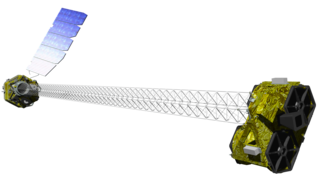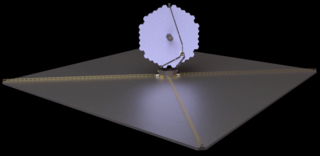
The Chandra X-ray Observatory (CXO), previously known as the Advanced X-ray Astrophysics Facility (AXAF), is a Flagship-class space telescope launched aboard the Space ShuttleColumbia during STS-93 by NASA on July 23, 1999. Chandra is sensitive to X-ray sources 100 times fainter than any previous X-ray telescope, enabled by the high angular resolution of its mirrors. Since the Earth's atmosphere absorbs the vast majority of X-rays, they are not detectable from Earth-based telescopes; therefore space-based telescopes are required to make these observations. Chandra is an Earth satellite in a 64-hour orbit, and its mission is ongoing as of 2023.

XMM-Newton, also known as the High Throughput X-ray Spectroscopy Mission and the X-ray Multi-Mirror Mission, is an X-ray space observatory launched by the European Space Agency in December 1999 on an Ariane 5 rocket. It is the second cornerstone mission of ESA's Horizon 2000 programme. Named after physicist and astronomer Sir Isaac Newton, the spacecraft is tasked with investigating interstellar X-ray sources, performing narrow- and broad-range spectroscopy, and performing the first simultaneous imaging of objects in both X-ray and optical wavelengths.

NASA's series of Great Observatories satellites are four large, powerful space-based astronomical telescopes launched between 1990 and 2003. They were built with different technology to examine specific wavelength/energy regions of the electromagnetic spectrum: gamma rays, X-rays, visible and ultraviolet light, and infrared light.

The Center for Astrophysics | Harvard & Smithsonian (CfA), previously known as the Harvard–Smithsonian Center for Astrophysics, is an astrophysics research institute jointly operated by the Harvard College Observatory and Smithsonian Astrophysical Observatory. Founded in 1973 and headquartered in Cambridge, Massachusetts, United States, the CfA leads a broad program of research in astronomy, astrophysics, Earth and space sciences, as well as science education. The CfA either leads or participates in the development and operations of more than fifteen ground- and space-based astronomical research observatories across the electromagnetic spectrum, including the forthcoming Giant Magellan Telescope (GMT) and the Chandra X-ray Observatory, one of NASA's Great Observatories.
The Constellation-X Observatory was a mission concept for an X-ray space observatory to be operated by NASA; in 2008 it was merged with ESA and JAXA efforts in the same direction to produce the International X-ray Observatory project, announced on 24 July 2008.

The NASA Infrared Telescope Facility is a 3-meter (9.8 ft) telescope optimized for use in infrared astronomy and located at the Mauna Kea Observatory in Hawaii. It was first built to support the Voyager missions and is now the US national facility for infrared astronomy, providing continued support to planetary, solar neighborhood, and deep space applications. The IRTF is operated by the University of Hawaii under a cooperative agreement with NASA. According to the IRTF's time allocation rules, at least 50% of the observing time is devoted to planetary science.

NuSTAR is a NASA space-based X-ray telescope that uses a conical approximation to a Wolter telescope to focus high energy X-rays from astrophysical sources, especially for nuclear spectroscopy, and operates in the range of 3 to 79 keV.

An X-ray telescope (XRT) is a telescope that is designed to observe remote objects in the X-ray spectrum. In order to get above the Earth's atmosphere, which is opaque to X-rays, X-ray telescopes must be mounted on high altitude rockets, balloons or artificial satellites.

SRON Netherlands Institute for Space Research (SRON) is the Dutch expertise institute for space research. The institute develops and uses innovative technology for analysis in space, focusing on astrophysical research, earth observation, and exoplanetary research. SRON has a line of research into new and more sensitive sensors for X-rays, infrared radiation and visible light.

Hitomi, also known as ASTRO-H and New X-ray Telescope (NeXT), was an X-ray astronomy satellite commissioned by the Japan Aerospace Exploration Agency (JAXA) for studying extremely energetic processes in the Universe. The space observatory was designed to extend the research conducted by the Advanced Satellite for Cosmology and Astrophysics (ASCA) by investigating the hard X-ray band above 10 keV. The satellite was originally called New X-ray Telescope; at the time of launch it was called ASTRO-H. After it was placed in orbit and its solar panels deployed, it was renamed Hitomi. The spacecraft was launched on 17 February 2016 and contact was lost on 26 March 2016, due to multiple incidents with the attitude control system leading to an uncontrolled spin rate and breakup of structurally weak elements.
Advanced Telescope for High-ENergy Astrophysics (Athena) is an X-ray observatory mission selected by European Space Agency (ESA) within its Cosmic Vision program to address the Hot and Energetic Universe scientific theme. Athena will operate in the energy range of 0.2–12 keV and will offer spectroscopic and imaging capabilities exceeding those of currently operating X-ray astronomy satellites – e.g. the Chandra X-ray Observatory and XMM-Newton – by at least one order of magnitude on several parameter spaces simultaneously.

Gravity and Extreme Magnetism Small Explorer mission was a NASA space observatory mission. The main scientific goal of GEMS was to be the first mission to systematically measure the polarization of X-ray sources. GEMS would have provided data to help scientists study the shape of spacetime that has been distorted by a spinning black hole's gravity and the structure and effects of the magnetic fields around neutron stars. It was cancelled by NASA in June 2012 for potential cost overruns due to delays in developing the technology and never moved into the development phase.

The Astronomy and Astrophysics Decadal Survey is a review of astronomy and astrophysics literature produced approximately every ten years by the National Research Council of the National Academy of Sciences in the United States. The report surveys the current state of the field, identifies research priorities, and makes recommendations for the coming decade. The decadal survey represents the recommendations of the research community to governmental agencies on how to prioritize scientific funding within astronomy and astrophysics. The editing committee is informed by topical panels and subcommittees, dedicated conferences, and direct community input in the form of white papers summarizing the state of the art in each subdiscipline. The most recent report, Astro2020, was released in 2021.

The International X-ray Observatory (IXO) is a cancelled X-ray telescope that was to be launched in 2021 as a joint effort by NASA, the European Space Agency (ESA), and the Japan Aerospace Exploration Agency (JAXA). In May 2008, ESA and NASA established a coordination group involving all three agencies, with the intent of exploring a joint mission merging the ongoing XEUS and Constellation-X Observatory (Con-X) projects. This proposed the start of a joint study for IXO. NASA was forced to cancel the observatory due to budget constraints in fiscal year 2012. ESA however decided to reboot the mission on its own developing Advanced Telescope for High Energy Astrophysics as a part of Cosmic Vision program.

The Large Ultraviolet Optical Infrared Surveyor, commonly known as LUVOIR, is a multi-wavelength space telescope concept being developed by NASA under the leadership of a Science and Technology Definition Team. It is one of four large astrophysics space mission concepts studied in preparation for the National Academy of Sciences 2020 Astronomy and Astrophysics Decadal Survey.

The X-Ray Imaging and Spectroscopy Mission, formerly the X-ray Astronomy Recovery Mission (XARM), is an X-ray space telescope mission of the Japan Aerospace Exploration Agency (JAXA) in partnership with NASA to provide breakthroughs in the study of structure formation of the universe, outflows from galaxy nuclei, and dark matter. As the only international X-ray observatory project of its period, XRISM will function as a next generation space telescope in the X-ray astronomy field, similar to how the James Webb Space Telescope, Fermi Space Telescope, and the Atacama Large Millimeter Array (ALMA) Observatory are placed in their respective fields. The mission is a stopgap for avoiding a potential observation period gap between X-ray telescopes of the present and those of the future. Without XRISM, a blank period in X-ray astronomy may arise in the early 2020s due to the loss of Hitomi. During its formulation, XRISM/XARM was also known as the "ASTRO-H Successor" or "ASTRO-H2".

Origins Space Telescope (Origins) is a concept study for a far-infrared survey space telescope mission. A preliminary concept in pre-formulation, it was presented to the United States Decadal Survey in 2019 for a possible selection to NASA's large strategic science missions. Origins would provide an array of new tools for studying star formation and the energetics and physical state of the interstellar medium within the Milky Way using infrared radiation and new spectroscopic capabilities.

Imaging X-ray Polarimetry Explorer, commonly known as IXPE or SMEX-14, is a space observatory with three identical telescopes designed to measure the polarization of cosmic X-rays of black holes, neutron stars, and pulsars. The observatory, which was launched on 9 December 2021, is an international collaboration between NASA and the Italian Space Agency (ASI). It is part of NASA's Explorers program, which designs low-cost spacecraft to study heliophysics and astrophysics.

Arcus is a proposed X-ray space observatory proposed to NASA's Explorer program, Medium Explorer (MIDEX) class.





















